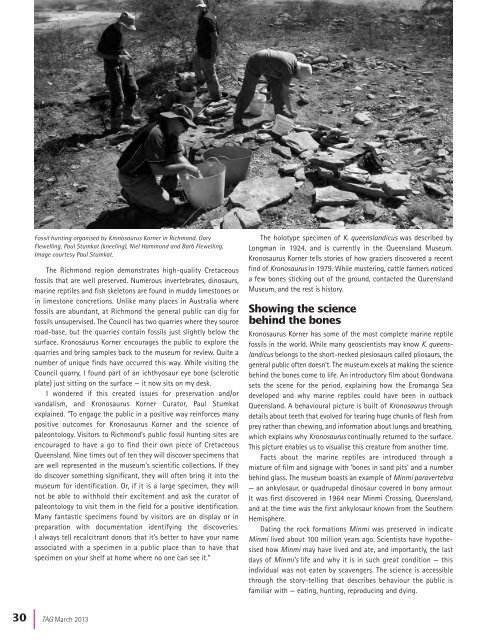TAG 166 - Geological Society of Australia
TAG 166 - Geological Society of Australia
TAG 166 - Geological Society of Australia
You also want an ePaper? Increase the reach of your titles
YUMPU automatically turns print PDFs into web optimized ePapers that Google loves.
Fossil hunting organised by Kronosaurus Korner in Richmond. GaryFlewelling, Paul Stumkat (kneeling), Niel Hammond and Barb Flewelling.Image courtesy Paul Stumkat.The Richmond region demonstrates high-quality Cretaceousfossils that are well preserved. Numerous invertebrates, dinosaurs,marine reptiles and fish skeletons are found in muddy limestones orin limestone concretions. Unlike many places in <strong>Australia</strong> wherefossils are abundant, at Richmond the general public can dig forfossils unsupervised. The Council has two quarries where they sourceroad-base, but the quarries contain fossils just slightly below thesurface. Kronosaurus Korner encourages the public to explore thequarries and bring samples back to the museum for review. Quite anumber <strong>of</strong> unique finds have occurred this way. While visiting theCouncil quarry, I found part <strong>of</strong> an ichthyosaur eye bone (scleroticplate) just sitting on the surface — it now sits on my desk.I wondered if this created issues for preservation and/orvandalism, and Kronosaurus Korner Curator, Paul Stumkatexplained. “To engage the public in a positive way reinforces manypositive outcomes for Kronosaurus Korner and the science <strong>of</strong>paleontology. Visitors to Richmond’s public fossil hunting sites areencouraged to have a go to find their own piece <strong>of</strong> CretaceousQueensland. Nine times out <strong>of</strong> ten they will discover specimens thatare well represented in the museum’s scientific collections. If theydo discover something significant, they will <strong>of</strong>ten bring it into themuseum for identification. Or, if it is a large specimen, they willnot be able to withhold their excitement and ask the curator <strong>of</strong>paleontology to visit them in the field for a positive identification.Many fantastic specimens found by visitors are on display or inpreparation with documentation identifying the discoveries.I always tell recalcitrant donors that it’s better to have your nameassociated with a specimen in a public place than to have thatspecimen on your shelf at home where no one can see it.”The holotype specimen <strong>of</strong> K. queenslandicus was described byLongman in 1924, and is currently in the Queensland Museum.Kronosaurus Korner tells stories <strong>of</strong> how graziers discovered a recentfind <strong>of</strong> Kronosaurus in 1979. While mustering, cattle farmers noticeda few bones sticking out <strong>of</strong> the ground, contacted the QueenslandMuseum, and the rest is history.Showing the sciencebehind the bonesKronosaurus Korner has some <strong>of</strong> the most complete marine reptilefossils in the world. While many geoscientists may know K. queenslandicusbelongs to the short-necked plesiosaurs called pliosaurs, thegeneral public <strong>of</strong>ten doesn’t. The museum excels at making the sciencebehind the bones come to life. An introductory film about Gondwanasets the scene for the period, explaining how the Eromanga Seadeveloped and why marine reptiles could have been in outbackQueensland. A behavioural picture is built <strong>of</strong> Kronosaurus throughdetails about teeth that evolved for tearing huge chunks <strong>of</strong> flesh fromprey rather than chewing, and information about lungs and breathing,which explains why Kronosaurus continually returned to the surface.This picture enables us to visualise this creature from another time.Facts about the marine reptiles are introduced through amixture <strong>of</strong> film and signage with ‘bones in sand pits’ and a numberbehind glass. The museum boasts an example <strong>of</strong> Minmi paravertebra— an ankylosaur, or quadrupedal dinosaur covered in bony armour.It was first discovered in 1964 near Minmi Crossing, Queensland,and at the time was the first ankylosaur known from the SouthernHemisphere.Dating the rock formations Minmi was preserved in indicateMinmi lived about 100 million years ago. Scientists have hypothesisedhow Minmi may have lived and ate, and importantly, the lastdays <strong>of</strong> Minmi’s life and why it is in such great condition — thisindividual was not eaten by scavengers. The science is accessiblethrough the story-telling that describes behaviour the public isfamiliar with — eating, hunting, reproducing and dying.30 |<strong>TAG</strong> March 2013
















